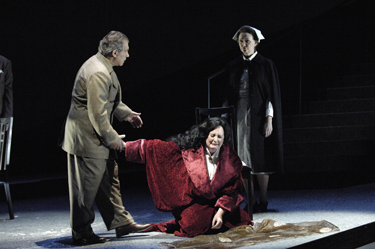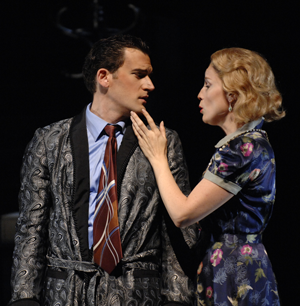05 Jun 2007
Pasatieri’s return to opera impressive
The June 2 world premiere of “Frau Margot” at the Fort Worth Opera might be regarded as “an historic return,” for this is Thomas Pasitieri’s first opera in 18 years.

The June 2 world premiere of “Frau Margot” at the Fort Worth Opera might be regarded as “an historic return,” for this is Thomas Pasitieri’s first opera in 18 years.
And the work has all the markings of a masterpiece; indeed, it gives rise to the hope that he has another opera up his sleeve.
The composer of a spate of operas, Pasatieri is best known for “The Seagull,” premiered at the Houston Grand Opera in 1984. A few years later he put opera aside and moved to Hollywood. (If you’ve seen “American Beauty,” “Fried Green Tomatoes” or “Magnolia” you’ve heard him — probably without realizing it.)
“Frau Margot” is a collective endeavor that involved the talents of many people over a long period of time. “Nest egg” was a report brought to librettist and director Frank Corsaro from Vienna by Leonard Bernstein. The then young conductor/composer had visited Helene Berg, widow of composer Alban Berg, whose opera “Lulu” was left incomplete when he died in 1935. Bernstein - like many others - sought permission to finish the score from Berg’s sketches for a third act. (Performances of the completed two acts had become common.)
Frau Berg refused after consulting with her late husband through a sèance, the Internet of that age of rampant spiritualism. (A good bit of laudanum helped her make the connection.) The widow refused permission — as she continued to do until her death in 1978.
Corsaro made a play of Bernstein’s story and called it “Lyric Suite,” the title of Berg’s most performed chamber work. However, given the near-universal aversion to dissonant music, he was unable to find a producer. On a visit to New York in 2003 Pasatieri told Corsaro, the director of the Houston “Seagull” and several other works by the composer, that he wanted to return to opera. Corsaro gave him his play. Then FWO general director Darren Woods ran into Corsaro and Pasatieri at a party. Woods was seeking a project for “down the road,” and “Frau Margot” was commissioned.
 Corsaro then turned his drama into a detective story, a Gothic tale of a widow’s murder of a
former mistress of her husband. (It was long suspected that Frau Berg kept the “Lulu” fragment
under wraps because it documented her husband’s extra-marital activity.) Corsaro gave the
characters fictional names and began the new version with an investigation of the murder,
followed by a flashback to the Bernstein story. The young composer shared the beds of both the
widow and of Kara Sondstrom, who had been the mistress of the deceased master. He set the
story in Amsterdam, which, however, is clearly a facade for Freud’s Vienna with its seething,
all-pervasive sexuality. In that l’art pour l’art age “reality” had become an elusive concept that
allows us — as Hugo von Hofmannsthal, the greatest poet of the age, said — “to play theater —
play the characters in our own dramas.”
Corsaro then turned his drama into a detective story, a Gothic tale of a widow’s murder of a
former mistress of her husband. (It was long suspected that Frau Berg kept the “Lulu” fragment
under wraps because it documented her husband’s extra-marital activity.) Corsaro gave the
characters fictional names and began the new version with an investigation of the murder,
followed by a flashback to the Bernstein story. The young composer shared the beds of both the
widow and of Kara Sondstrom, who had been the mistress of the deceased master. He set the
story in Amsterdam, which, however, is clearly a facade for Freud’s Vienna with its seething,
all-pervasive sexuality. In that l’art pour l’art age “reality” had become an elusive concept that
allows us — as Hugo von Hofmannsthal, the greatest poet of the age, said — “to play theater —
play the characters in our own dramas.”
At first glance it might seem that the librettist muddied the waters needlessly with his additions to music history. Things were complex enough in the Berg household without emendations. Yet even the shadow of lesbianism that darkens the co-dependency that bind Margot to Kara is no more than a reflection of the obsession of fin-de-siècle Vienna with matters of the flesh. About the city at that time Viennese author Stefan Zweig wrote that “the air felt perfumed and unhealthy; a dishonest morality hung over us like a nightmare.” And man-about-town Karl Kraus commented that Vienna was “spiritually bankrupt.” And it was in spite — or perhaps precisely because — of that it was also the scene of a golden age in the arts.
With amazing success Pasatieri has captured all this in a score of a voluptuous splendor that suggests Klimt’s gilded paintings set to music. And this is what makes “Frau Margot” a masterpiece, for the composer has not only laid bare the nervous mental machinations of his characters; he has rendered turn-of-the-century Vienna with its undertow of threatening darkness audible. A muted sadness speaks from the libretto’s reference to “the hope for that love that sustains the fragile heart and makes life durable.” This melancholy sounds again from the final confession of the major male characters in the opera: “I have not lived the life I meant to live.” “Life and death,” Corsaro writes, “are one and the same.” Small wonder that Pasatieri’s gorgeous music speaks with heavy eyelids.
The score — three hours with two intermissions — pulses with an uninterrupted rapture that draws listeners into the music, putting them — as it were — on stage in the middle of the action. Two changes, however, must be made. The “barber-shop” quartet of waiters in Act One breaks with the style of the work and should be excised. And the spoof of ageing divas was especially tasteless when such senior sopranos as Catherine Malfitano and Evelyn Lear — both with long-standing connections to the FWO — were in the audience for the premiere in Fort Worth’s handsome Bass Performance Center.
“Frau Margot” was written for Lauren Flanigan, who in the title role could easily be taken for one of Klimt’s well-born models. And her fundamentally lyric soprano has just the dramatic heft that the part demands. “Stumbling along in her loneliness,” as the libretto says, she was here a stunning incarnation of the uneasy splendor of the age.
 As Kara Sondstrom, the friend who betrayed Margot, Patricia Risley provided exactly the
contrast between the two women required by the score. And baritone Morgan Smith as Ted
Steiner, the composer who had set out to complete the unfinished opera in question, is young,
handsome and innocent enough to get caught in this spider web of erotic desire without full
awareness of what stood before him.
As Kara Sondstrom, the friend who betrayed Margot, Patricia Risley provided exactly the
contrast between the two women required by the score. And baritone Morgan Smith as Ted
Steiner, the composer who had set out to complete the unfinished opera in question, is young,
handsome and innocent enough to get caught in this spider web of erotic desire without full
awareness of what stood before him.
The “who-done-it?” frame within which the story is told was nicely provided by Canadian bass-baritone Daniel Okulitch, and Alan Glassman had the required maturity to make his unrequited love for Margot touching.
The single set by Alison Nalder was entirely in black and white with scene changes achieved through enlarged background projections of buildings and people. Costumes true to the period were by Steven Bryant.
FWO music director Joseph Illick, involved in early workshops on the score, demonstrated a refined understanding of the work, and members of the Fort Worth Symphony outdid themselves in recreating the lush “feel” of the story’s era.
“Frau Margot” has been the centerpiece of Fort Worth Opera’s 60th anniversary celebration, which has witnessed a total reshaping of the company’s season. In recent years FWO has spaced three productions during the fall/winter season. Now it has consolidated them in a three-week early summer festival that focuses special attention on both the FWO and its home city.
“Frau Margot” has alternated on stage with “Madama Butterfly” and “Falstaff,” and in a joint enterprise with the city’s Cliburn Concerts the festival included a gala performance Rossini’s Petite Messe Solennelle. (Fort Worth is home to pianist Van Cliburn and the international competition that honors him.) In 1981 FWO commissioned a children’s opera from Thomas Pasatieri and that adds yet another layer of meaning to his “return” to opera — and Fort Worth — with “Frau Margot.”
Pasatieri, born in 1945, was a prodigy both as pianist and composer. He studied in France with Nadja Boulanger and earned the first doctorate given by the Juilliard School.
Footnote: It was an open secret in imperial Vienna that Helene Berg was the child of Kaiser Franz Joseph I, whose mistress her mother had been. A singer of note, she was cut from the same cloth as femme fatale Alma Mahler. Indeed, it seems that Corsaro and Pasatieri have given Frau Margot something of the allure of the legendary Alma.
Wes Blomster